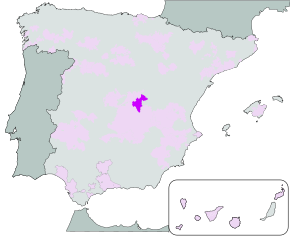Uclés (wine region)
The Denominación de Origen ( DO ) Uclés wine-growing region has existed since April 2005, making it one of the youngest classified wine-growing regions in Spain . It is named after the village of Uclés in the province of Cuenca . The definition of this area goes back to the initiative of eight wineries who wanted to market the region's potential for producing wines under their own name.
location
The DO Uclés is located in the southern part of the central Spanish plateau southeast of Madrid in the autonomous community of Castile-La Mancha . Divided by the Sierra Altomira mountain range, it includes 25 villages in the province of Cuenca in the east ( El Acebrón , Alcázar del Rey , Almendros , Belinchón , Carrascosa del Campo , Fuente de Pedro Naharro , Horcajo de Santiago , Huelves , Huete , Langa , Loranca del Campo , Paredes , Pozorrubio , Rozalén del Monte , Saelices , Tarancón , Torrubia del Campo , Tribaldos , Uclés , Valparaiso de Arriba , Valparaiso de Abajo , Vellisca , Villamayor de Santiago , Villarrubio and Zarza de Tajo ) and three villages in the province of Toledo in western part ( Cabezamesada , Corral de Almaguer and Santa Cruz de la Zarza ). A total of around 175,000 ha is defined; However, wine that meets the requirements of the DO Uclés is only grown on approximately 1,500 hectares.
climate
The climate is semi-arid , continental, with very hot summers and very cold winters. The amount of precipitation is about 500 mm / year, the dry season prevails throughout the summer.
ground
The geological conditions differ greatly within the region, but mostly soils with a deep sandy or loamy structure are used for viticulture. In some river valleys, alluvial clay soil is also used.
Wine
Originally, only the red wine grapes Tempranillo (Cencibel), Grenache , Cabernet Sauvignon , Merlot and Syrah were allowed to produce wines with DO Uclés status .
With the revision of the DO statutes of September 2008, the white grape varieties Chardonnay , Macabeo (Viura), Moscatel de grano menudo , Sauvignon Blanco and Verdejo are also permitted.
Only grapes from vines that are at least six years old may be used for red wines. In addition, corresponding yield limits apply, depending on the age of the vines. In the case of white wines, grapes from annual grapes can be used.
The alcohol content of red wines must be at least 12% vol., And white wines 10% vol. Since September 2009, the production of rosé wine with a minimum alcohol content of 11.5% vol. And sparkling wine with at least 10% vol. Alcohol is permitted.
